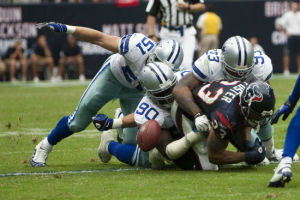
Several articles have come out in early September examining whether there may be a connection between two problems currently plaguing the National Football League: Concussions and domestic violence.
Concussions are a mild form of traumatic brain injury (TBI). They have been a major problem in the NFL – and all levels of the sport – for many years. In 2013 alone, 228 concussions were diagnosed among NFL players, according to the league’s annual Health & Safety Report.
The problem has recently received heightened attention due to research indicating a link between repeated concussions and brain disease such as chronic traumatic encephalopathy (CTE).
Additionally, the NFL is now facing a class-action lawsuit filed by players who claim that the league concealed information about the relationship between concussions and brain injuries for many years while trying to protect its brand.
On September 12, both the NFL and the players released actuarial data as part of a proposed $765 million settlement of that litigation. As the Associated Press reports, the data indicates that about 28 percent of the league’s players are expected to develop Alzheimer’s disease or other forms of dementia.
At the same time as this information comes out, the NFL has been dealing with a string of domestic violence incidents involving figures such as the Baltimore Ravens’ Ray Rice and Minnesota Vikings’ Adrian Petersen.
Expert: Link Between Head Trauma, Domestic Violence ‘A Plausible Hypothesis’
Since early September, Forbes, NBC News and the New Republic have come out with articles that have taken a closer look at whether there may be a connection between the repeated head trauma that NFL players suffer over the course of their careers and the league’s unusually high domestic violence arrest rate.
In the Forbes article, writer Dan Diamond interviews several experts, including Adrian Raine, a psychologist at the University of Pennsylvania who studies how brain function can explain criminal behavior.
“It’s a very, very important question,” Raine tells Forbes after being asked whether football players’ repeated head trauma may be connected to domestic violence. “It’s a plausible hypothesis, without a doubt.”
Taking a Closer Look at Aggression and Brain Damage
The Forbes article, citing information compiled by FiveThirtyEight.com, points out that domestic violence has accounted for 48 percent of arrests for violence crimes among NFL players, compared to an estimated 21 percent nationally.
The article goes on to discuss how a study by Raine found “neural abnormalities” in the brains of men arrested for domestic violence.
The problem could be congenital but it’s also possible that it could be the result of external trauma, the researcher indicates. He notes that the frontal lobes of the brain are “very much involved in emotion regulation.” That is the same area of the brain that can be damaged in a typical football head injury.
Linda Carroll of NBC also examines this matter. For her article, she spoke with Douglas Smith of the University of Pennsylvania’s Center for Brain Injury and Repair. Smith explains that aggression is a common aspect of severe TBI and is generally linked to damage to the frontal lobes.
In the New Republic, writer Naomi Shavin notes two studies that focused on the relationship between violent behavior and brain trauma:
- A 1986 study of 15 death row inmates which found that each one had suffered some type of traumatic brain injury as a child
- A 1996 study which found that, out of 279 Vietnam War veterans who had suffered penetrating brain injuries, those with damage to the frontal cortex had shown more aggressive behavior.
In an update to his initial article, Forbes’ Diamond adds that several players who were diagnosed with CTE after their deaths “ran into trouble with the law” for domestic violence incidents towards the end of their lives, including Junior Seau and Dave Duerson.
Consensus: No Clear Connection Between Domestic Violence, Head Trauma
As the Forbes, NBC News and New Republic articles all clearly state, there has been no research establishing a link between repetitive brain trauma and domestic violence among NFL players.
In fact, several experts quoted in the articles point out problems with such a theory.
The University of Wisconsin at Madison’s Dr. Alison Brooks tells the New Republic that many other factors could contribute to violent behavior by pro football players. For instance, people who are prone to high-risk behavior, including football players, tend to be more prone to aggressive behavior, Brooks states.
Dr. Andre Douglas Pond Cummings of Indiana Tech tells the New Republic that, in his view, the game’s violent culture may have much to do with the issue.
Dr. Michael Wolf of the Drexel University School of Medicine cautions against making “big claims based on isolated events,” while Dr. David Hovda of the UCLA Brain Injury Research Center points to the fact that concussions and violence do not seem to be an issue in the general population.
“If concussions caused violent behavior, you’d expect to see millions of people shooting each other,” Hovda tells NBC News.
Forbes: Issue Deserves Close Attention
Reacting to Hovda’s comment, Forbes’ Diamond points out that the “key issue” is not whether an isolated concussion leads a person to become aggressive and violent but rather whether “repeated head trauma [such as that experienced by NFL players] lowers a person’s self-control” and possibly explains, in part, what appears to be a serious domestic violence issue among the league’s players.
Forbes goes on to quote Raines as comparing the issue to that of smoking and lung cancer: Some people develop lung cancer, while many others don’t. However, Raines states, it’s clear that smoking raises the odds of lung cancer, “just as damage to the prefrontal cortex can raise the odds of impulsive, aggressive behavior.”
Image by AJ Guel from Flickr